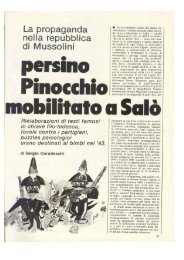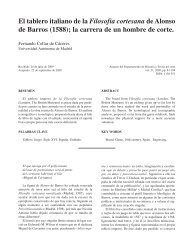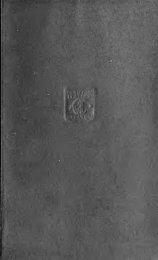Board games from the city of Vijayanagara (Hampi ... - Gioco dell'Oca.
Board games from the city of Vijayanagara (Hampi ... - Gioco dell'Oca.
Board games from the city of Vijayanagara (Hampi ... - Gioco dell'Oca.
You also want an ePaper? Increase the reach of your titles
YUMPU automatically turns print PDFs into web optimized ePapers that Google loves.
<strong>Board</strong> <strong>games</strong> <strong>from</strong> <strong>the</strong> <strong>city</strong> <strong>of</strong> <strong>Vijayanagara</strong><br />
(<strong>Hampi</strong>), 1336-1565: a survey and a study /<br />
Rangachar Vasantha<br />
Austere and grandiose <strong>Hampi</strong> is <strong>the</strong> site <strong>of</strong> <strong>the</strong> last capital <strong>of</strong> <strong>the</strong> last great Hindu<br />
kingdom <strong>of</strong> <strong>Vijayanagara</strong>, whose rich kings built Dravidian temples and palaces,<br />
which won <strong>the</strong> admiration <strong>of</strong> travelers between <strong>the</strong> 14th and 16th centuries.<br />
Conquered by <strong>the</strong> Muslims in 1565, <strong>the</strong> <strong>city</strong> was pillaged over a period <strong>of</strong> six months,<br />
and <strong>the</strong>n abandoned.<br />
The greater parts <strong>of</strong> <strong>the</strong> more interesting buildings are situated in <strong>the</strong> citadel or innermost<br />
line <strong>of</strong> fortifications and also along <strong>the</strong> roadside to <strong>Hampi</strong>. The crowded buildings<br />
hint at <strong>the</strong> centuries-old heritage <strong>of</strong> <strong>the</strong> village, for it is some 450 years since <strong>Hampi</strong>’s<br />
grandeur came to an end as <strong>the</strong> center <strong>of</strong> <strong>the</strong> <strong>Vijayanagara</strong> Empire. The present day village<br />
preserves <strong>the</strong> ancient order while its inhabitants reap <strong>the</strong> benefits <strong>of</strong> being a living<br />
example <strong>of</strong> old peaceful ways. The Mohammedan invasion and especially <strong>the</strong> employment<br />
<strong>of</strong> Mohammedan troops by <strong>the</strong> <strong>Vijayanagara</strong> kings led to Saracenic features being<br />
adopted in some <strong>of</strong> <strong>the</strong> buildings in <strong>the</strong>ir capital, producing an Indian version <strong>of</strong> that<br />
style known as Indo-Saracenic.<br />
The Vijayanagar capital was probably at first situated at Anegundi on <strong>the</strong> nor<strong>the</strong>rn<br />
bank <strong>of</strong> <strong>the</strong> Tungabhadra river nearly opposite <strong>the</strong> present hamlet <strong>of</strong> <strong>Hampi</strong>. As <strong>the</strong><br />
empire grew in size and power, <strong>the</strong> capital was moved to <strong>the</strong> sou<strong>the</strong>rn bank <strong>of</strong> <strong>the</strong> river<br />
and Anegundi was retained as a fortified suburb or outpost.<br />
The cultural remains <strong>of</strong> <strong>the</strong> imperial <strong>city</strong> <strong>of</strong> <strong>Vijayanagara</strong> now spread over a vast area<br />
<strong>of</strong> about 25 km covering several modern villages, while <strong>the</strong> outer lines <strong>of</strong> its fortifications<br />
include still a larger area. There are temples and entrances formed out <strong>of</strong> <strong>the</strong> huge rocks<br />
everywhere. The monuments which are popularly known as <strong>Hampi</strong> ruins are mainly situated<br />
between <strong>the</strong> villages <strong>of</strong> Kamalapuram in <strong>the</strong> south to <strong>Hampi</strong> village on <strong>the</strong> right<br />
bank <strong>of</strong> Tungabhadra river in <strong>the</strong> north.<br />
The Virupaksha Temple in <strong>the</strong> middle <strong>of</strong> <strong>Hampi</strong> Bazaar commands most respect. It<br />
hovers above <strong>the</strong> hills and trees <strong>the</strong> boulders and <strong>the</strong> mirror like rock pools calling you<br />
back to <strong>the</strong> 700-meter long avenue. Along <strong>the</strong> Tungabhadra river <strong>the</strong> Vithala Temple,<br />
with its stone chariot is <strong>the</strong> world heritage site. “<strong>Hampi</strong>” was added to UNESCO’s World<br />
Heritage List in 1986.<br />
<strong>Board</strong> Games <strong>from</strong> <strong>Hampi</strong><br />
The City <strong>of</strong> <strong>Vijayanagara</strong> <strong>of</strong>fers unique opportunities to investigate Indian board<br />
<strong>games</strong> in <strong>the</strong> pre-modern era. Archaeological and architectural evidence provides a<br />
remarkable record <strong>of</strong> board <strong>games</strong> <strong>of</strong> various types in <strong>the</strong> place called <strong>Hampi</strong>, which was<br />
probably <strong>the</strong> most extensive <strong>of</strong> any Hindu capital in India. The contemporary literary<br />
works in Kannada, Sanskrit and Telugu, as well as <strong>the</strong> graphic description <strong>of</strong> contemporary<br />
foreign visitors help in unearthing <strong>the</strong> varieties <strong>of</strong> board <strong>games</strong> found in <strong>the</strong><br />
ruined structures, un-cleared rubble piles and numerous overgrown mounds.







